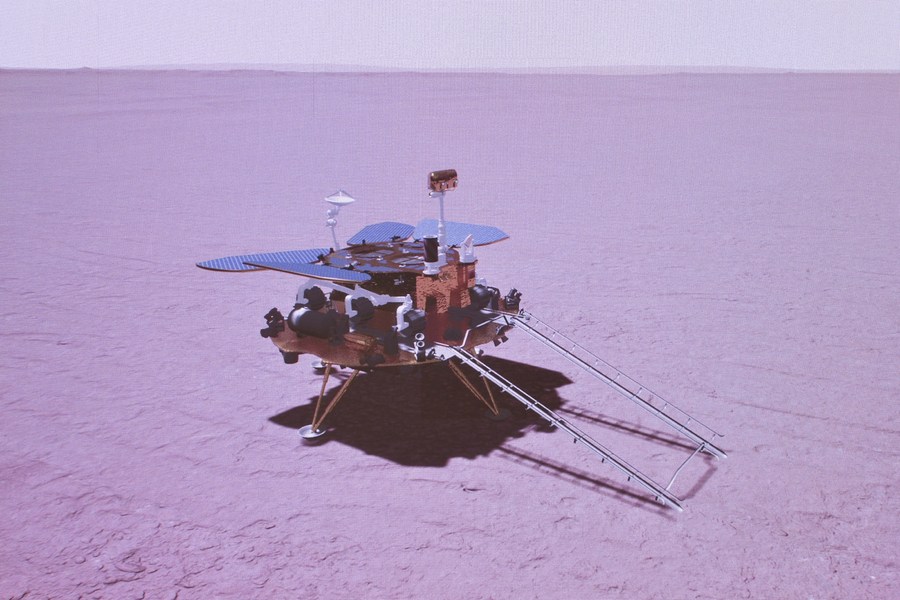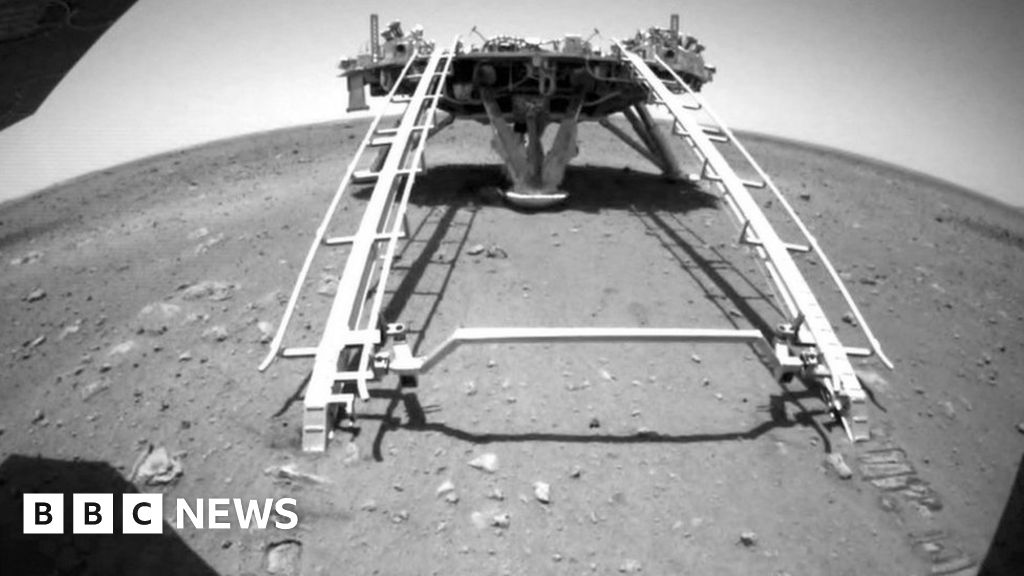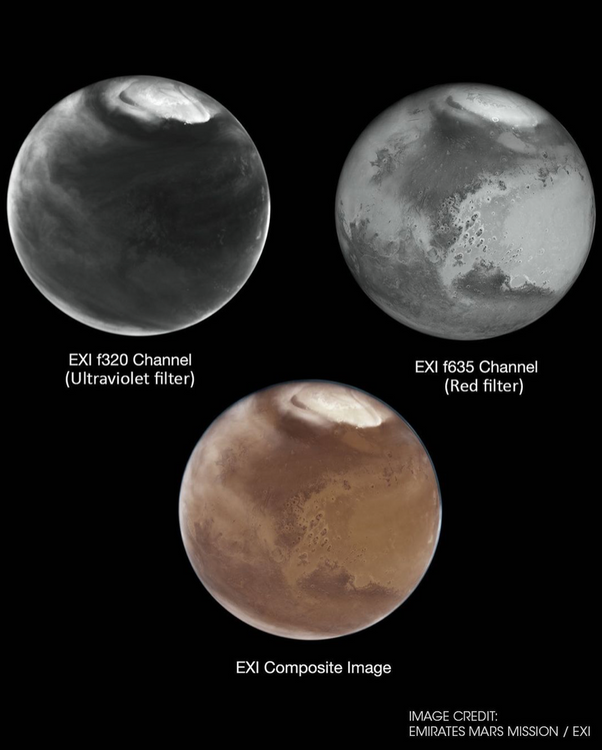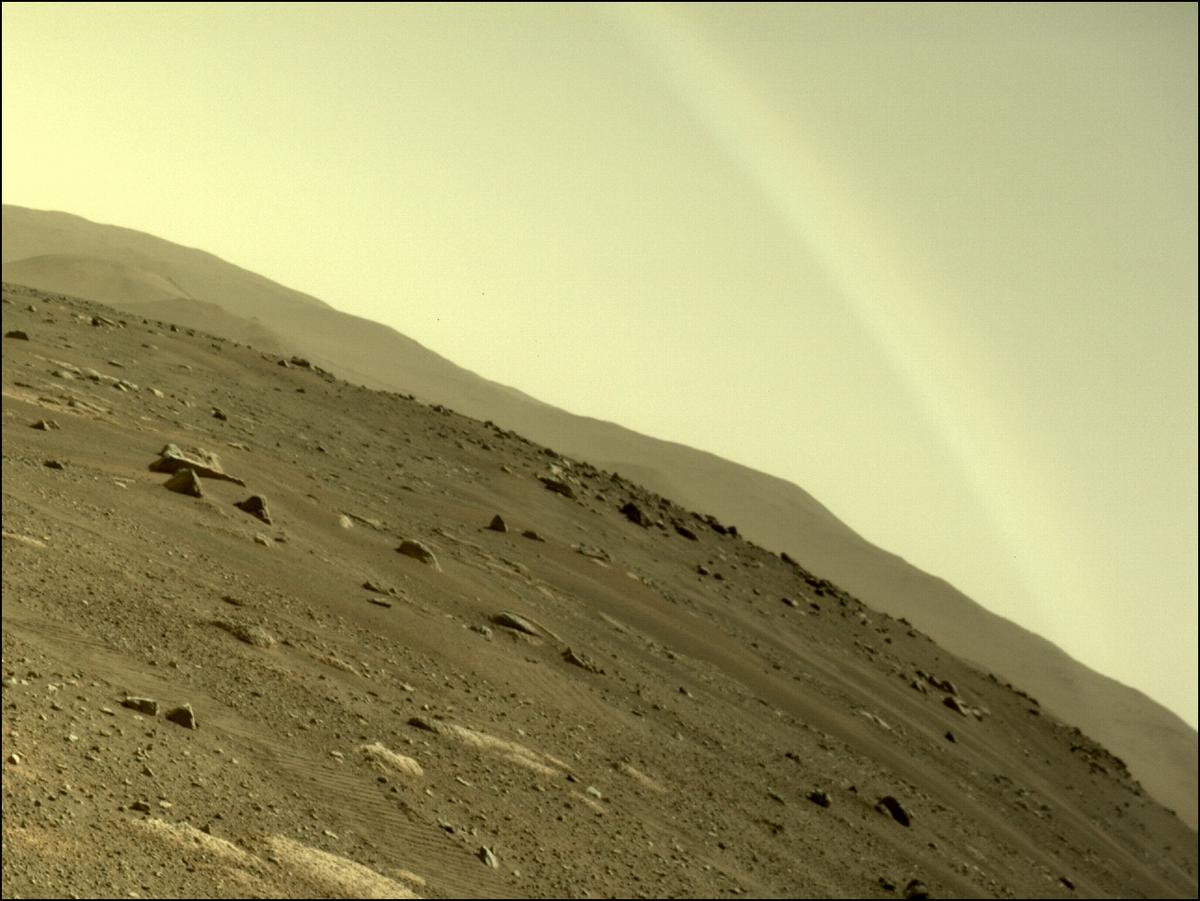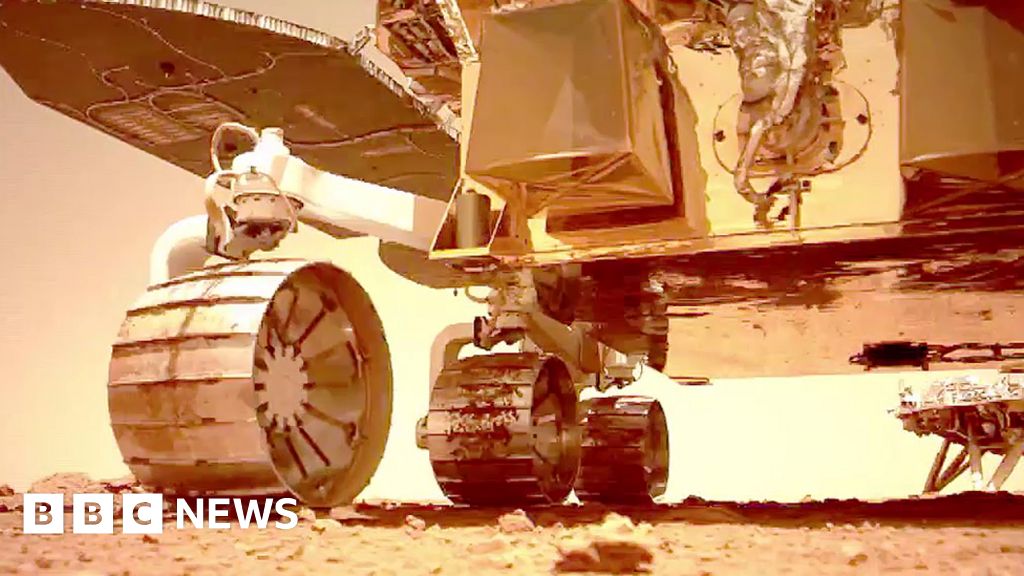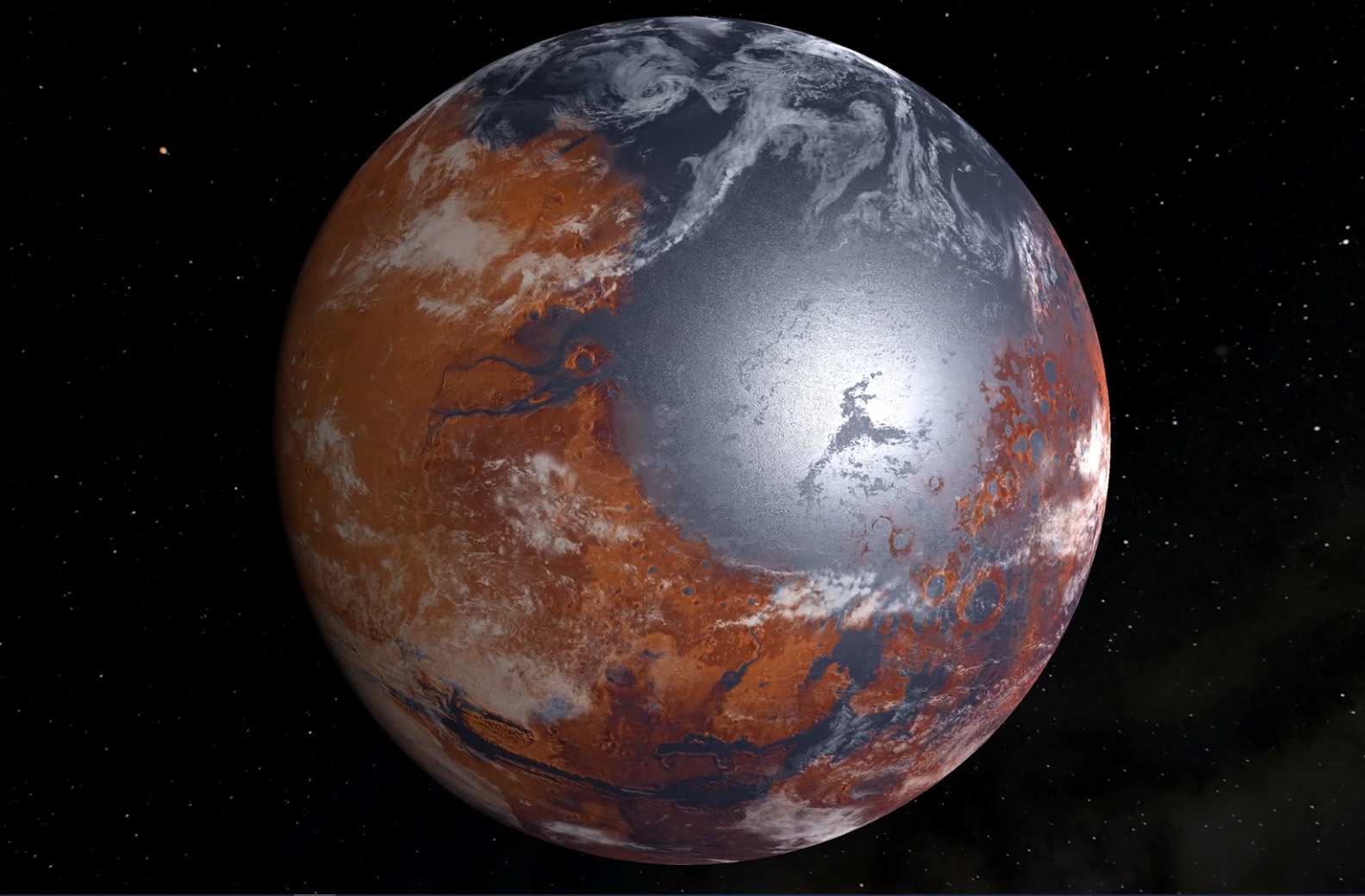China’s Tianwen 1 mission targets mid-May landing on Mars
April 1, 2021 (no joking) by Stephen Clark (Spaceflight Now)

China’s Tianwen 1 orbiter took this picture of Mars on March 18 from a distance of approximately 7,100 miles (11,500 kilometers). Credit: CNSA
China’s Tianwen 1 spacecraft — in orbit around Mars since February — is scheduled to deploy a descent module to attempt the country’s first landing on the Red Planet in mid-May. Officials plan to share the Mars rover’s scientific data with researchers around the world, a senior Chinese scientist said last week.
Chinese officials have not announced the exact date for the attempted Mars landing. Tianwen 1 mission managers have more flexibility in setting the landing date than officials on other Mars missions.
Tianwen 1 will release its lander and rover from its position in orbit around Mars. Most Mars landers, such as NASA’s Perseverance rover, enter the Martian atmosphere on a direct course from Earth. Those trajectories typically have preset landing dates tied to when the missions launched.
Wang Chi, director of the National Space Science Center at the Chinese Academy of Sciences, said March 23 that Tianwen 1’s lander and rover are scheduled to touch down on Mars in May.
“The first Chinese Mars mission, Tianwen 1, is now orbiting Mars, and we are landing in the middle of May,” Wang said in a presentation to the National Academies’ Space Studies Board. “We are open to international cooperation, and the data will be available publicly soon.”
The Tianwen 1 spacecraft entered orbit around Mars on Feb. 10, completing a nearly seven-month interplanetary journey that began last July with a launch on a heavy-lift Long March 5 rocket, the most powerful launcher in China’s inventory.
The arrival of the Tianwen 1 spacecraft at Mars made China the sixth country or space agency have a probe orbiting the Red Planet, following the United States, the former Soviet Union, the European Space Agency, India, and the United Arab Emirates.
Since Feb. 10, the Tianwen 1 spacecraft has maneuvered into an orbit closer to Mars. The orbiter’s current path takes it as close as 174 miles (280 kilometers) and as far as 36,660 miles (59,000 kilometers) from Mars. Tianwen 1 completes one lap around the Red Planet every two days or so.
Tianwen 1 arrived at Mars one day after the UAE’s Hope orbiter steered into orbit around the Red Planet, and eight days before landing of NASA’s Perseverance rover. The favorable planetary alignment of Earth and Mars that allowed the three missions to reach Mars in February comes once every 26 months.

A camera ejected from China’s Tianwen 1 spacecraft captured this view of the probe in deep space last year on the journey from Earth to Mars. The Tianwen 1 mission’s lander and rover are inside the white heat shield. Credit: China National Space Administration
Tianwen 1’s lander and rover will target landing in a broad plain in the northern hemisphere of Mars called Utopia Planitia.
If China pulls off that feat, it will make China the third country to perform a soft landing on Mars — after the Soviet Union and the United States — and the second country to drive a robotic rover on the Red Planet.
The Tianwen 1 orbiter, which will continue its mission after releasing the lander and rover, is designed to operate for at least one Martian year, or about two years on Earth. The solar-powered rover, fitted with six wheels for mobility, has a life expectancy of at least 90 days, Chinese officials said.
Once it releases the lander and rover, the Tianwen 1 orbiter will adjust its orbit to transition into regular science operations. The orbiter will also relay communications signals between ground controllers in China and the rover exploring the Martian surface.
The Tianwen 1 rover is cocooned inside a heat shield for a fiery descent to the surface of Mars. After releasing from the orbiter mothership, the lander will enter the Red Planet’s atmosphere, deploy a parachute, then fire a braking rocket to slow down for landing.
Assuming the landing is successful, the rover will activate cameras, a subsurface radar, sensors to measure the composition of Martian rocks, a magnetic field monitor, and a weather station to begin collecting data at the Utopia Planitia location.
With the recent arrivals of China’s Tianwen 1 and the UAE’s Hope missions, there are now eight orbiters operating at Mars.
NASA’s Odyssey spacecraft, the Mars Reconnaissance Orbiter, and the MAVEN atmospheric observatory are currently returning data from Mars orbit, along with the European Space Agency’s Mars Express and ExoMars Trace Gas Orbiter, and India’s Mars Orbiter Mission.
NASA said last week had a “limited exchange” of information with China’s space agency since Tianwen 1’s arrival at the Red Planet to share data on the orbits of the Mars orbiters. The data-sharing initiative is aimed at reducing the risk of collisions between spacecraft operating at Mars, NASA said.
A provision in law known as the Wolf Amendment prohibits most bilateral cooperation between the U.S. and Chinese space programs. The Wolf Amendment is named after former Rep. Frank Wolf, R-Virginia, who first inserted the language into a NASA budget bill in 2011.
But the law does not restrict all contact between NASA and China’s space agency, provided the proposed collaboration passes a review by the FBI, and NASA informs Congress of the exchange at least 30 days ahead of time.
The China National Space Administration confirmed in a statement Wednesday that it held “working level meetings” with NASA from January through March on “exchanging ephemeris data to ensure the flight safety of Mars spacecraft.”
While NASA’s collaboration with China’s space program is limited, other nations have been more involved in Chinese missions like Tianwen 1.
Scientists from the Institut de Recherche en Astrophysique et Planétologie, or IRAP, in France contributed to a Laser-Induced Breakdown Spectroscopy instrument on the Tianwen 1 rover.
French scientists, with support from the French space agency CNES, provided guidance to their Chinese counterparts on the spectroscopy technique, which uses a laser to zap a pinhead-size portion of a rock, and a spectrometer to analyze the light given off by plasma generated by the laser’s interaction with the rock’s surface.
The technique allows an instrument to determine the chemical make-up of rocks on Mars. French scientists also provided China with a calibration target for the rover’s laser spectroscopy instrument.
The same French team worked on instruments on NASA’s Curiosity and Perseverance Mars rovers. The scientists hope to cross-calibrate measurements between the two U.S.-led missions and China’s Tianwen 1 rover.
Scientists from the Space Research Institute at the Austrian Academy of Sciences assisted in the development of the magnetometer on the Tianwen 1 orbiter and helped calibrate the flight instrument.
Argentina is home to a Chinese-owned deep space tracking antenna used to communicate with Tianwen 1. The European Space Agency also agreed to provide communications time for Tianwen 1 through its own worldwide network of deep space tracking stations.













